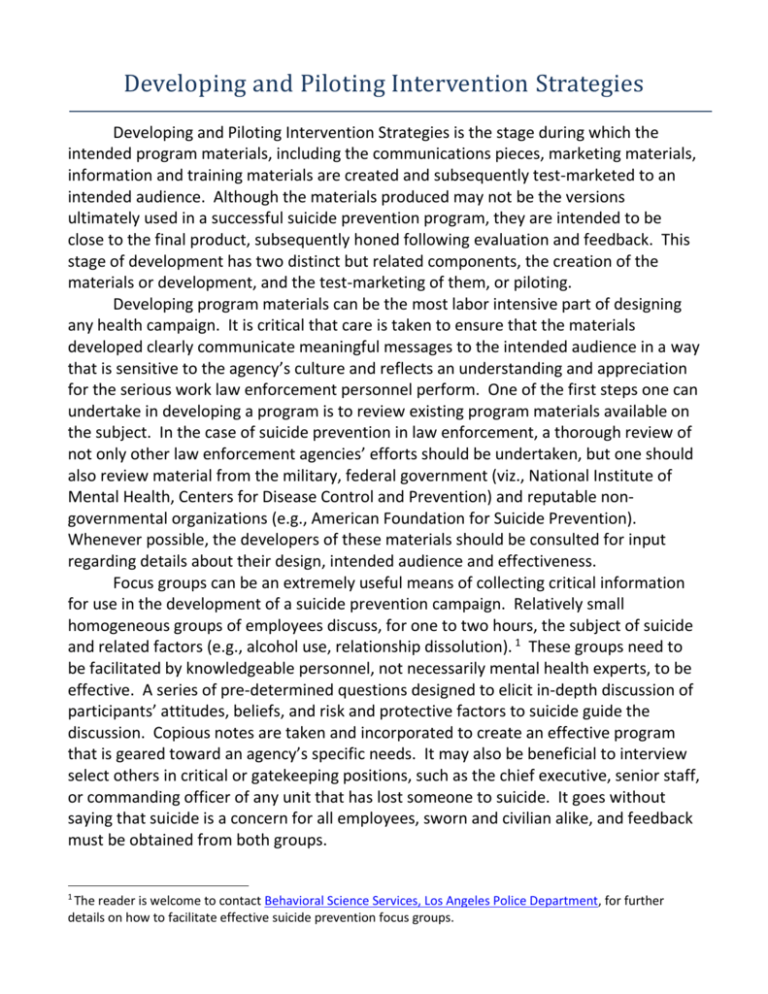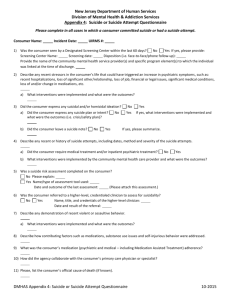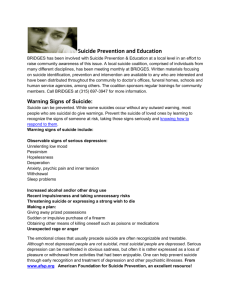Developing and Piloting Intervention Strategies
advertisement

Developing and Piloting Intervention Strategies Developing and Piloting Intervention Strategies is the stage during which the intended program materials, including the communications pieces, marketing materials, information and training materials are created and subsequently test-marketed to an intended audience. Although the materials produced may not be the versions ultimately used in a successful suicide prevention program, they are intended to be close to the final product, subsequently honed following evaluation and feedback. This stage of development has two distinct but related components, the creation of the materials or development, and the test-marketing of them, or piloting. Developing program materials can be the most labor intensive part of designing any health campaign. It is critical that care is taken to ensure that the materials developed clearly communicate meaningful messages to the intended audience in a way that is sensitive to the agency’s culture and reflects an understanding and appreciation for the serious work law enforcement personnel perform. One of the first steps one can undertake in developing a program is to review existing program materials available on the subject. In the case of suicide prevention in law enforcement, a thorough review of not only other law enforcement agencies’ efforts should be undertaken, but one should also review material from the military, federal government (viz., National Institute of Mental Health, Centers for Disease Control and Prevention) and reputable nongovernmental organizations (e.g., American Foundation for Suicide Prevention). Whenever possible, the developers of these materials should be consulted for input regarding details about their design, intended audience and effectiveness. Focus groups can be an extremely useful means of collecting critical information for use in the development of a suicide prevention campaign. Relatively small homogeneous groups of employees discuss, for one to two hours, the subject of suicide and related factors (e.g., alcohol use, relationship dissolution). 1 These groups need to be facilitated by knowledgeable personnel, not necessarily mental health experts, to be effective. A series of pre-determined questions designed to elicit in-depth discussion of participants’ attitudes, beliefs, and risk and protective factors to suicide guide the discussion. Copious notes are taken and incorporated to create an effective program that is geared toward an agency’s specific needs. It may also be beneficial to interview select others in critical or gatekeeping positions, such as the chief executive, senior staff, or commanding officer of any unit that has lost someone to suicide. It goes without saying that suicide is a concern for all employees, sworn and civilian alike, and feedback must be obtained from both groups. 1 The reader is welcome to contact Behavioral Science Services, Los Angeles Police Department, for further details on how to facilitate effective suicide prevention focus groups. Once the various communication and educational materials have been developed, the agency is best advised to pilot the material on a moderate size group of employees. In the short period of time that you pilot a program, you are not assessing whether suicide behaviors or the suicide rate drops, there is usually not a large enough number of participants nor enough time to determine specific effectiveness. What you are in essence doing is exposing a (preferably random) group of employees of varying tenure, rank and assignment, to the program you have developed and eliciting their feedback and recommendations. Just as focus groups may have been used in the development of the program, they may also be utilized to elicit meaningful and detailed feedback about the pilot program. Other means of obtaining feedback include on-line and in-person surveys, although response rates are usually very low. The specific nature of the feedback sought should correspond to the goals and objectives of an agency’s suicide prevention program. Furthermore, feedback should specifically address the individual components of each communications piece and training material. Effective program development, implementation and evaluation take time but are well worth the investment on the front end. Law enforcement agencies often feel the heightened pressure to respond to negative events such as a suicide with rapid intervention. Fast response is part of our culture. However, suicide prevention programs can be labor intensive and need to be well thought through to be effective.









